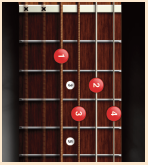The E7 Chord
“Issue 6 and we’re only on E7”, I here you wail. “Nothing more interesting?” Well there is, but in the past we have demo’d more unusual chords and thought it would be good to showcase a more common chord that can be used effectively in loads of positions on the neck; and it is both distinctive and melodic. It is also easy to lob in a bit of theory behind it. You don’t have to sound boring talking about E7 in detail, but throw in the words sub-dominant and you just could sound knowledgeable.
So as we have just pointed out, there are several (easy) positions on the fretboard in which you can play the E7 Chord. One really cool thing is that, in the open position, you can play the same E7 chord with either 2 or 4 fingers; each one crating a different sound. The 4 fingered version being less subtle and, definitely, more distinctive. First of all, give these two positions a work out.
Now, in the intro of I saw Her Standing There by The Beatles, George Harrison uses these two versions of the chord to create some distinctive melody lines, switching between them and also including, this position on the third and fourth frets. (Top E – 4TH fret, B – 3rd: G – 4th: D – Open)
That’s 3 positions, and here are 2 more which sound really cool and are great to use when playing blues or rock ‘n roll.
Position 4 – Bottom E – Open; A – 7: D – 6: G – 7: B – 5: Top E – Open
Position 5 – Bottom E – Open; A – 7: D – 6: G – 7: B – Open: Top E – Open
Try using them strumming heavily, then shorten the length of the notes by releasing the pressure of your left hand. You will see this results in a drastic change in feel and mood. Party animal to cool dude (especially if you slow down the tempo).
…and here are the chord diagrams to assist you.
Another thing to remember, is that the bottom (low) E string can provide you with an additional E bass note on any of these chord shapes if you want or need to thicken up the chord.
Using E7 in chord progressions.
As you probably know already, just about every classic rock ‘n roll song using a 12 bar blues sequence contains a 7th – think Roll Over Beethoven, Johnny B. Good, Great Balls of Fire – and change the key from A to E, or B and slip in the ‘ole E7 chord. It will sound good even if the original doesn’t use it.
For example:
Key of E………E7/E7/E7/E7/A/A/E7/E7/B/A/E7/B
Key of A……….A/A/A/A/D/D/A/A/E7/D7A/E7
Key of B………B/B/B/B/E7/E7/B/B/F#/F#/E7/B7/F#7
There also loads of other progressions using E7, so try some of these out for size:
Bm7 / E7 / A / F#m7
D / E7 / G / A
F / E7 / Am / G
E7 / A / D / C#
Am / E7 / F / C
………..and, of course, experiment with your own and get those creative juices flowing.






